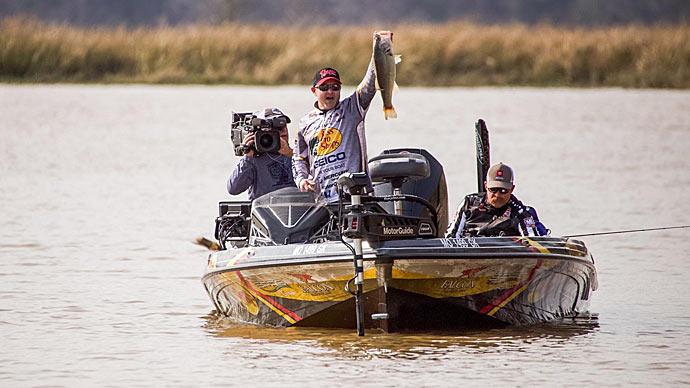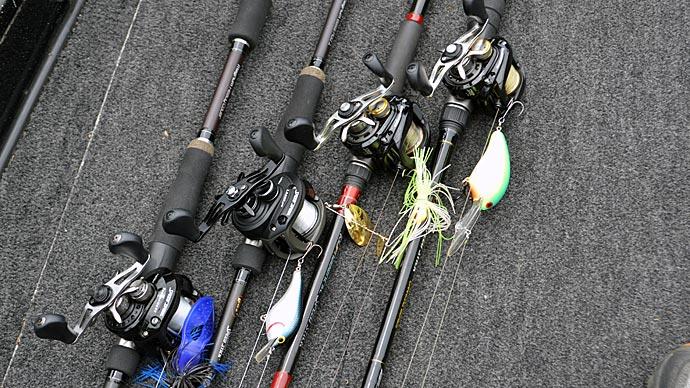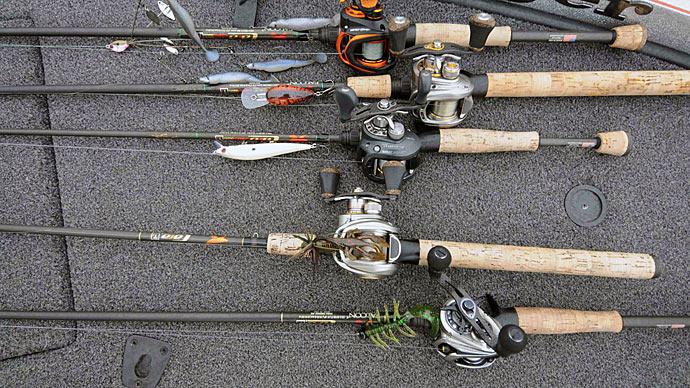
How do you choose one rod from another? Let's assume that you are going down to your local discount store, such as Wal-Mart. There you see a large selection to pick from. Your first decision is will the rod be spinning or baitcasting. What length do you want? What power do you require? And what type of grip do you prefer? How many line guides does the rod have? Does the rod have the proper action? And finally, what presentation will you use the rod for primarily? You say to yourself: "So what does all this have to do with buying a rod for bass fishing?"
Guess what! Everything, that's right, I said everything. Because all of these questions relate to how a rod will react when fished. Now I have observed people looking at different rods in a store with no idea what they are looking for. They seem to pick a rod more for its appearance than how it might fish. So let's examine the different types of rods used for Bass fishing today.
The first rod can be used for several applications: Blade, Spoon, or a soft Stickbait rod. This rod should be made of standard or intermediate Modulus graphite. It should be a six-foot casting rod with fast action in the medium to heavy power range. It should have six eyes in addition to the tip. Of course, it would have your choice of the grip material.
The next rod we will look at is the "Heavy Cover" rod: Primarily used for flipping and pitching. This rod is made from High Modulus graphite such as IM6. It is a seven-foot casting rod with fast to extra-fast action and heavy power. Any quality rod will have a guide for each foot of length plus the tip.
What's next? Oh yea, the Carolina Rig rod: This is also a High Modulus Rod six foot six inches to seven feet long. It can be casting or spinning with fast action and medium to heavy power.
Then there is the "Crankbait" or "Balsa wood Stickbait" rod: This rod is ideally made of fiberglass or at least a composite. Just ask David Fritts what he uses. It is either a casting or spinning rod, six foot six inches to seven feet long. It has a moderate action with medium power.
Now comes the good ole "Topwater" rod: This also is a fiberglass or composite rod. The reason is that fiberglass and composites are softer and therefore more giving when you set the hook. And who hasn't jerked the lure out of a fish's mouth before? The Topwater rod is a six-inch to six-foot casting rod of moderate action with medium power.
Oh boy, one of my favorites: The "Spinnerbait" rod. Although casting is preferred, the spinnerbait rod is a six-foot composite blank in either spinning or casting blankblank in either spinning or casting. The rod should have moderate action with medium power.
Is anyone out there doing any smallmouth fishing? Here's a rod for you: The "Grub" rod. The Grub rod is a six-foot-long graphite blank and uses a spinning reel. It has fast action and medium power.
How about the "Finesse" rod? This is a High Modulus IM6 type blank. It's a six-foot-long spinning rod with moderate to fast action and light to medium light power. This rod is for when the bite is light, and you're using those great four-inch worms from Charlie Brewer or maybe Don Iovino.
And last but by no means least is the "Worm" rod. Now the worm rod is 100% graphite. It can be either spinning or casting, five foot eight inches to six foot six inches with fast action and light to medium power.
So there you are. When you go looking for that new fishing rod, you will know what to look for in a rod. Now, these do not trade secrets that I am giving away. But rather knowledge, the knowledge that every bass fisherman or woman should possess. But after all, the fishing rod is nothing more than an extension of your arm. It is a tool, and it will make you a better fisherman given the proper tools.




